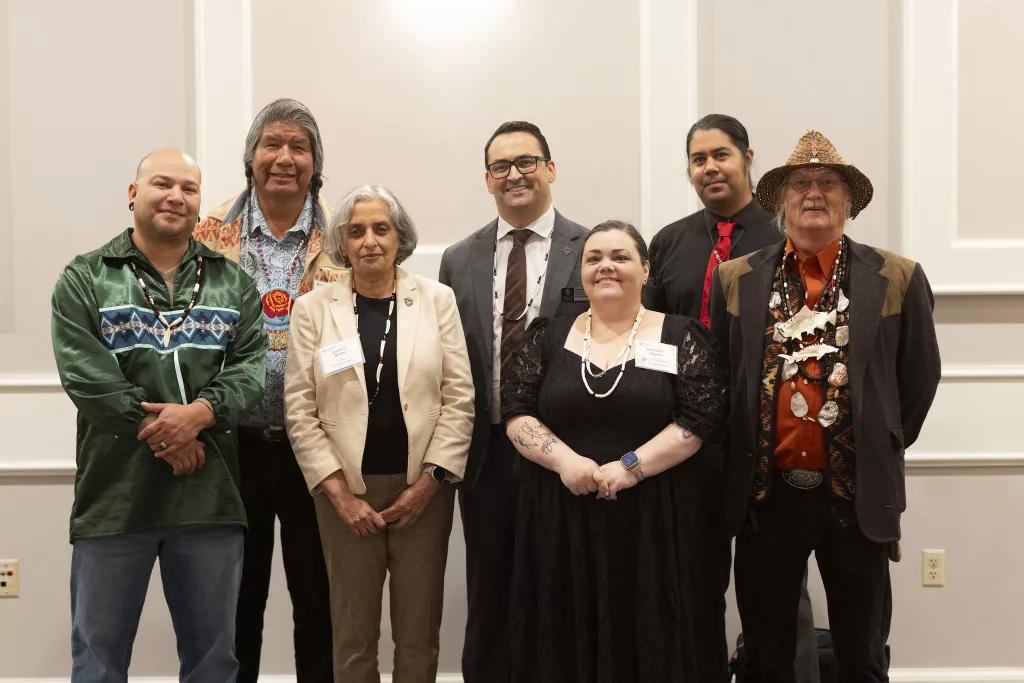From left to right: Chief Jefferson Greene Jr., Wasco Chief, Confederated Tribes of Warm Springs; Wilson Wewa, Tribal Council, Confederated Tribes of Warm Springs; Jayathi Murthy, Oregon State University president; Scott Vignos, Oregon State vice president and chief diversity officer; Dawn Marie Alapisco, director of the Native American Graves Protection and Repatriation Act office at Oregon State; Chance White-Eyes, director of Tribal relations at Oregon State; Chief Doug Barrett, Confederated Tribes of Coos, Lower Umpqua and Siuslaw Indians. Photo: Alteza Films.
CORVALLIS, Ore. – The nine federally recognized Tribes in Oregon and Oregon State University have worked together to build a university facility to facilitate the repatriation and return of tribal Ancestors and cultural items currently under the university’s stewardship.
Tribal leaders and university officials marked the transfer of Ancestors in Oregon State’s stewardship to the facility earlier this month.
The facility will serve as a space to carry out consultations, repatriations and ceremonies to advance the university’s obligations under the Native American Graves Protection and Repatriation Act (NAGPRA), which safeguards and facilitates the return of Native American and Native Hawaiian ancestral remains and certain cultural items.
The act requires federally funded institutions in possession of such items to inventory the holdings, consult with lineal descendants and/or federally recognized Native American Tribes and Native Hawaiian organizations for identification and confirmation of affiliation to ancestral remains and cultural items for the purposes of repatriation, where possible, to descendant communities today.
The facility at Oregon State is believed to be the first time an academic institution in the United States has built a dedicated facility in collaboration with Tribes to advance NAGPRA responsibilities and facilitate the repatriation of Ancestors and cultural items to their home communities.
“One of the ways in which institutions are building living relationships and creating repatriation policies that fit the needs of descendant communities is by putting Tribal nations and communities at the forefront of policy development,” said Briece Edwards of the Tribal Historic Preservation Office of the Confederated Tribes of Grand Ronde. “Oregon State University provides a recent example of creating repatriation and NAGPRA policies through a truly consultative and respectful process.”
Doug Barrett, chief of The Confederated Tribes of Coos, Lower Umpqua and Siuslaw Indians, said this work should be applauded.
“This is a really big deal and it needs to be a model that is followed across the nation,” Barrett said.
Scott Vignos, Oregon State University’s vice president and chief diversity officer, said the university’s actions align with its institutional values and land grant mission.
“Like many types of legislation, there is a floor that is compliance,” he said. “And then we need to consider ‘how can we go beyond compliance’ and into a place that seeks to connect our past, present and future by building relationships, acknowledging harm and pursuing reconciliation. That’s what we are trying to do here.”
Chance White Eyes, Oregon State’s director of tribal relations, shared similar sentiments.
“We can do the bare minimum, and we can get by, but that doesn’t honor people,” White Eyes said. “They have dealt with trauma and I would argue continue to be disrespected and dishonored. That’s what this is about – being honorable and respectful.”
The facility represents a shift in how NAGPRA is viewed and conducted – by putting tribal voices and needs at the forefront, said Dawn Marie Alapisco, Oregon State’s NAGPRA director.
“We go through this legal repatriation process as required by NAGPRA legislation, but we can do so in a way that is much more congruent with the values and cultural ideals of the Tribes we are in partnership with,” Alapisco said. “It is about honoring the humanity of Ancestors and their significance within Tribal communities today.”
The work to repatriate ancestral remains and cultural items will take years. Where appropriate, the facility is also intended to be available for NAGPRA aligned activities by other institutions and agencies in Oregon.
“Repatriation through NAGPRA is purposely deliberate because Tribes need to be given an opportunity to think, to reflect, to build capacity through a really difficult process,” Vignos said. “It’s less about how quickly we can get this done and more about how respectfully can we get this done.”

